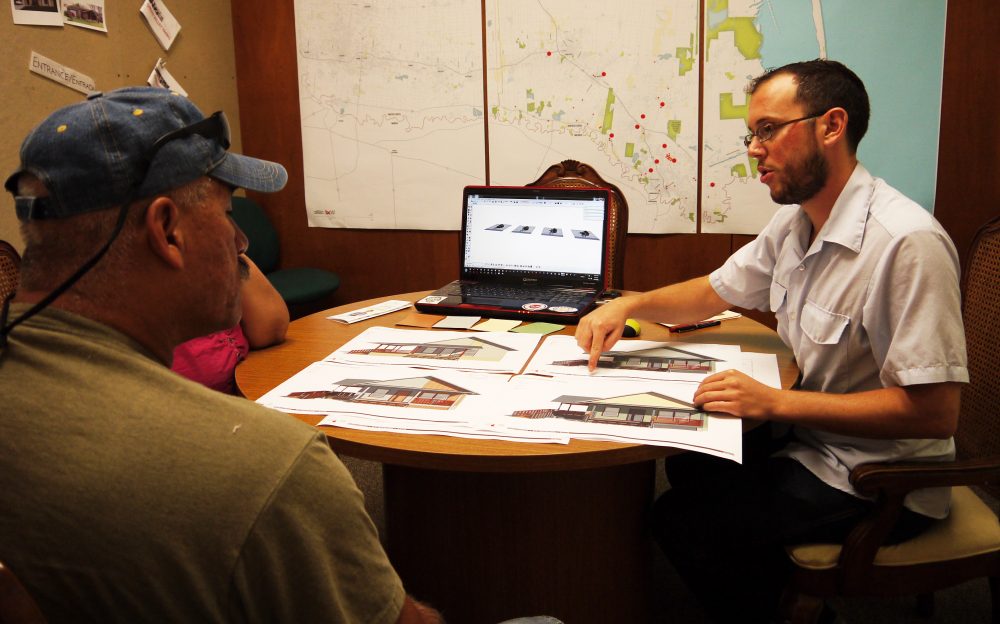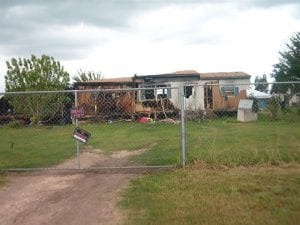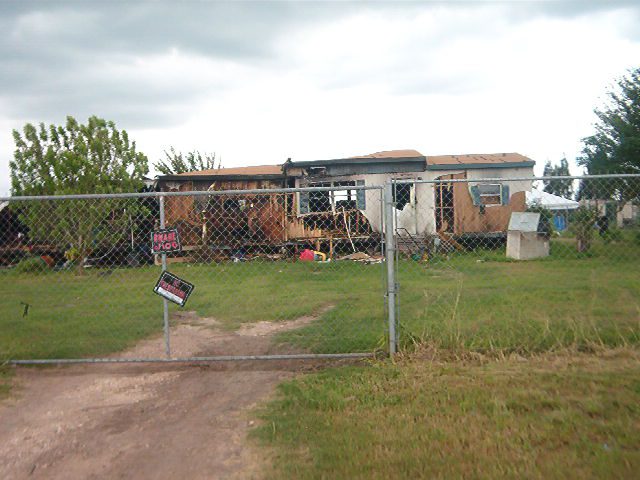
Housing designers with the Community Development Corporation of Brownsville (CDCB) meet with Colonia residents during a housing design process. CDCB allows clients to lead the design of their new home as it’s critical in growing their individual and community wealth. Photo courtesy of the Community Development Corporation of Brownsville

A Brownsville area residence that’s ready for demolition and reconstruction. Photo courtesy of the Community Development Corporation of Brownsville
There’s no doubt about it: there’s an immigration crisis at the border. However, we urge the nation to recognize another crisis at the southern border region, one that has affected local residents for many, many years.
Persistent poverty.
We at the Community Development Corporation of Brownsville are acutely aware of the impact the current immigration predicament has on local communities, specifically the strain imposed on areas that have experienced a high rate of poverty for a long time. Our community is located 1,700 miles southwest of our nation’s capital, far removed from powerful circles of political influence. The region, the Rio Grande Valley in Texas, is a wonderful place where two cultures have come together as one. It’s a place of low brush lands, wild parrots, sugar cane, and beautiful beaches. However, this southernmost stretch of the Texas-Mexico border is one of many rural persistent-poverty regions in the U.S. Our largest city, Brownsville, is often referred to as the poorest city in the country: 70 percent of the population is uninsured, the high school graduation rate is just 62.8 percent, and it’s here where you can find the lowest credit scores in the nation.
Decades of persistent poverty reveal the plight of low-wage working people who have not realized the country’s promise of economic prosperity. Border communities have witnessed years of disinvestment, and as a result, lack critical physical infrastructure and economic opportunity. They are geographically isolated from centers of innovation. Generational poverty is deeply entrenched and individuals face seemingly insurmountable obstacles while striving to escape the cycle of financial instability. Allowing poverty to become a permanent condition threatens the democratic ideals upon which our great nation was founded, and it poses a threat to our freedom to attain household financial stability, engage in upward economic mobility, and achieve financial resilience.
Persistent poverty is a crisis that requires urgent action.
Recent budget proposals from the White House would slash millions of dollars from projects and programs that help low-income residents who live in the border region, including programs that focus on health care, affordable housing, education, and infrastructure. Instead of addressing the dire needs of residents within our border, the president has declared a national emergency to support the funding of a 2,000-mile border wall. The White House has proposed the reallocation of $8.2 billion from the departments of the treasury and defense in order to fund the project.
Our region is acutely sensitive to the push and pull factors that increase migration from our southern neighbors. Flawed international treaties and immigration laws have created undue stress on an already fractured socioeconomic ecosystem on the border. The regional economy is sensitive to fluctuations and disruptions in international markets as billions of dollars of exports and imports circle through the ports of entry each year. Any attempt to create policies to end persistent poverty along the border must include a thoughtful and comprehensive analysis of immigration and border security.
A more judicious reallocation of $8.2 billion in federal funds would be to invest directly in persistent-poverty communities, and partner with local organizations that have a track record of improving infrastructure, affordable housing, education, and health care. This would create an immense multiplier effect that would enable our community to essentially work its way out of persistent poverty.
Over the last four decades, the Community Development Corporation of Brownsville (CDCB) has engaged in rigorous analysis of household balance sheets, baseline financial health metrics, and behaviors. We have uncovered contours in our households’ financial landscape that are not always evident from a cursory review of national data. As we closely examine financial profiles of low-wage earners in our region, we use an intentional wealth and equity perspective to interpret the implications of deep-rooted financial illness and instability. This analysis reveals that many individuals are trapped in a cycle of chronic financial illness. They:
- Earn low wages or maintain a fixed income.
- Fluctuate from one low-wage job to another and thus suffer from high rates of income volatility and incongruent income streams.
- Lack access to financial resources to weather an unexpected financial emergency.
- Are credit challenged, or credit invisible.
- Are largely operating in a financial desert where the ratio of mainstream financial service providers to predatory alternative financial providers is dismal.
- Experience financial strain across family networks.
- Lack access to culturally relevant financial literacy education.
- Are concentrated in sectors where employers do not provide health or retirement benefits.
Residents can’t escape the cycle of chronic financial illness long enough to experience financial resilience and freedom. While they might experience an increase in earnings and smooth their cash flow for a period of time, they have not yet been able to amass enough savings to weather a financial storm, and when it arrives they are once again dependent on predatory, high-cost, short-term credit products.
The consistent financial load carried by individuals who are trapped in the cycle of chronic financial illness and instability is a form of toxic stress and is evidenced through the continuous generations of families living in persistent poverty. Research from the American Academy of Pediatrics in 2011 found that children exposed to various forms of toxic stress, such as sustained family financial instability, are susceptible to an increased risk of adverse health and behavioral outcomes. The Asset Funders Network’s analysis of the 2013 Panel Study of Income Dynamics revealed that 22 percent of individuals with no financial assets reported being in fair or poor health when compared to 13 percent of those in the highest wealth segment. This toxic stress represents a perilous emergency with massive economic implications that warrants an immediate and massive intervention.
While some might note that the lower cost of living in our region should allow low-wage earners to stretch their income and cover more expenses, this assumption is inaccurate. For example, folks who live in the Brownsville-Harlingen area need to earn at least $13.81 an hour to cover the cost of a two-bedroom apartment at $718 per month, according to the 2019 Out of Reach report. Given that the average renter in our area earns $8.73 per hour, many rely on small-dollar loans as a consistent source of income patching to cover basic housing expenses. In Texas’s 34th Congressional District nearly one-third of all households are composed of renters and 26 percent are severely cost burdened, meaning they allocate at least half of their income for housing, according to the National Low-Income Housing Coalition’s Congressional District Housing Profile. Approximately 36,000 households who rent are under 50 percent of Area Median Income (AMI), and among those under 30 percent AMI, 65 percent are severely cost burdened. Currently there is a deficit of 29,742 affordable and available rental units for families in dire need of safe and adequate housing. The negative residual impacts of high-cost housing include increased levels of food insecurity, children living in poverty, and self-reporting of poor health, according the 2019 County Health Rankings and Roadmaps report.
Although persistent poverty is defined as a lack of income sustained over time, the impacts on an individual’s life are multidimensional and outweigh the federal funding mechanisms that offer support in silos. More than 80 means-tested programs provide medical benefits, housing and child care subsidies, workforce training, food assistance, and cash benefits over an individual’s life span. Multiple programs designed to provide support to persistently poor households are difficult to navigate and offer fragmented support. Similarly, the federal mechanisms that fund means-tested assistance are complex and rife with inconsistencies. Our region is in dire need of targeted and sustained federal investments of locally designed solutions. Rural persistent-poverty counties need more than poorly funded and fragmented programs, or federal prisons and call centers, to reduce unemployment rates and create economic development.
The dearth of traditional sound financial services in this region is evident by the high proportion of the population that is unbanked and living in rural colonias, purchasing a “home” through informal financing arrangements such as contract for deed. Yet they continue to express a desire to access mainstream financial services. Strategic investment in local CDFIs leverages resources and makes possible financing options to promote the development of affordable housing, small businesses, charter schools, healthy food networks, and alternative small-dollar consumer-lending products. Given the appropriate political will, the federal government is able to actively work toward eliminating persistent poverty by expanding publicly funded demonstration projects that integrate social services to meet the multifaceted needs of individuals and households residing in persistent poverty regions.
We realize that attempts to reduce the incidence of persistent poverty is a formidable challenge, one that requires patience, planning, community engagement, and a strong national political will.
While recent national attention has been drawn to the highly politicized influx of unaccompanied minors, the actual emergency in our region is the inability of individuals and families to escape deep-rooted intergenerational persistent poverty. While we in no way intend to minimize the need for comprehensive immigration reform, our sustained work reveals that the real crisis along the border is the pervasive persistent poverty produced by the constant income volatility and short-term liquidity constraints households face over extended periods of time, despite their active participation in the workforce.
The ramifications of persistent poverty have far-reaching impacts for individuals as well as the community. Thus, targeted investments in community economic development are necessary and should supersede financial support of border walls and military intervention. Some might be discouraged by the scope of the problem or feel paralyzed to help individuals and families far removed from immediate spheres of influence. A strategic investment of federal funds at the local level to support the development of innovative financial products and services would enable individuals in our region to escape the cycle of chronic financial illness, reduce the prevalence of persistent poverty, and change the intergenerational wealth trajectories for the families we serve, and for our community, our region, and our nation.






Comments